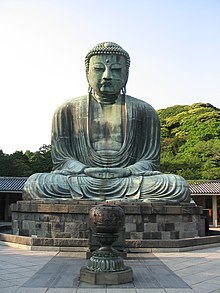Amitabha

Amitabha ( Sanskrit अमिताभ Amitābha ; Tibetan : 'Od dpag med / Snang ba mtha' yas ; chinese 阿彌陀佛 / 阿弥陀佛 , Pinyin Ēmítuófó , W.-G. O-mi-t'o fo ; Jap. 阿弥陀仏 , Amida butsu or 阿 弥陀 如 来 , Amida nyorai , "Buddha of the Immeasurable Shine of Light") is a transcendent Buddha , who is most venerated in the entire Sino-Japanese and East Asian region.
overview
His kingdom Sukhavati is one of several Pure Lands into which a person is to be born by reciting the name Amitabhas (see Nianfo ).
The Amitabha worship is the focus of various Buddhist denominations, of which the Chinese School of the Pure Land ( Chinese淨土 宗 / 净土 宗Pinyin Jìngtǔzōng W.-G. Ching-t'u-tsung) and the Japanese schools of Jōdo-shū and the Jōdo-Shinshū are the most famous.
The school referring to Buddha Amitabha is also called Amidism or Amitabha Buddhism .
Amitabha also plays an important role in Tibetan Buddhism Vajrayana and is considered the original Buddha of the lotus family ( Adibuddha ). There are various practices in Tibetan Buddhism for gaining access to the Pure Land of Amitabha, such as Sablam Phowa . Padmasambhava is seen in Tibetan Buddhism as an incarnation or emanation of Amitabha.
Amitabha is the Buddha of total love . He lives in tranquility (representation as a meditating Buddha) and works for the enlightenment of all beings (representation as a blessing Buddha). His most important enlightenment technique is the visualization of the surrounding world as pure land. Whoever understands his world as pure land awakens the enlightenment energy in himself. The world as pure land can be seen through a corresponding clear and unlimited view (spirit of enlightenment) or by sending light to all beings (wishes all beings happy). According to the Amitabha doctrine, one awakens after physical death in the pure land (the Pure Land Amitabhas, Sanskr. Ogmin, Tib. Dewachen) when one thinks of one's name as a mantra and the mind leaves the body through the crown chakra .
literature
- Christoph Kleine : The Buddhism of the Pure Land: From the Chinese and Japanese tradition. Berlin, Berlin: Insel Verlag; Verlag der Weltreligionen, 2015. ISBN 978-3-458-70053-1
- Volker Zotz : The Buddha in the Pure Land . Diederichs, Munich 1991, ISBN 3-424-01120-7
- Hisao Inagaki , Harold Stewart (Translator): The Three Pure Land Sutras. Berkeley: Numata Center for Buddhist Translation and Research 2003. ISBN 1-886439-18-4 PDF
- Müller, F. Max (trans): Buddhist Mahâyâna texts Vol.2: The larger Sukhâvatî-vyûha, the smaller Sukhâvatî-vyûha, the Vagrakkedikâ, the larger Pragñâ-pâramitâ-hridaya-sûtra, the smaller Pragñâ-pâramitâ-hridaya-sûtra . The Amitâyur dhyâna-sûtra, translated by J. Takakusu. Oxford, Clarendon Press 1894. Digitized
- Daisetz Teitaro Suzuki : Amida. The Buddha of love. Bern, Munich 1974. ISBN 3-502-62592-1
Web links
- Christoph Kleine : Salvation through faith and grace. The Japanese Amida Buddhism. ( [1] on buddhismuskunde.uni-hamburg.de)

